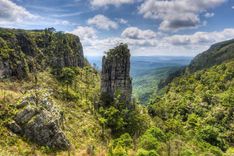3. The Wild Coast, Eastern Cape
The Wild Coast is remote, rugged, and untamed in the best way. Stretching around 350 miles from East London to the KwaZulu-Natal border, this dramatic coastline winds through deep river valleys, rolling hills, and steep cliffs.
While the main N2 highway runs through the region, the real magic begins when you turn off onto the gravel roads that lead to villages and coastal hideaways. You will pass traditional Xhosa homes, known as rondavels, set against green hills where cattle graze freely. Life here moves slowly, and the roads often do too.
This region was once called the Transkei, a former apartheid-era homeland with deep political significance. It was home to Nelson Mandela and Steve Biko, and their lives are remembered at several local heritage sites. The history is rich, and the connection to the land and community is still strong.
Coffee Bay is a good place to pause, with easy access to the Hole in the Wall, a natural sea arch surrounded by cliffs and breaking waves. The beach here is one of the most scenic in the region and easily ranks among the best beaches in South Africa, especially if you prefer yours with more cows than crowds. Port St Johns is another key stop, where rivers, forest, and coastal trails offer plenty of room to explore, along with long stretches of unspoiled sand framed by green cliffs.
While you will not find a traditional South African safari here, the Wild Coast still delivers for nature lovers. Look out for dolphins in the surf, birdlife in the forests, and wide open spaces that stretch all the way to the sea.
Where does this trip start and end?
Most travelers begin in East London and finish near Port Edward, at the northeastern edge of the Eastern Cape. Along the way, main stops include Coffee Bay, Port St Johns, and Lusikisiki. This is not a loop, and travel times vary depending on road conditions. Many local roads are unpaved, so a high-clearance vehicle is recommended.
How long does this road trip take?
You should plan to spend at least four to six days exploring the Wild Coast. Road conditions can slow your pace, and that is part of the experience. More time means more chances to explore coastal hikes, visit local villages, and take in the natural beauty without rushing.














